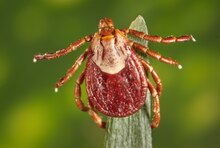User:Rashaaasfour/Colorado tick fever
Cause[edit]
Virology[edit]
| Colorado tick fever coltivirus | |
|---|---|
| Virus classification | |
| (unranked): | Virus |
| Realm: | Riboviria |
| Kingdom: | Orthornavirae |
| Phylum: | Duplornaviricota |
| Class: | Resentoviricetes |
| Order: | Reovirales |
| Family: | Sedoreoviridae |
| Genus: | Coltivirus |
| Species: | Colorado tick fever coltivirus
|
The virus particle, like other coltiviruses, is about 80 nm in diameter and is generally not enveloped. The double-stranded RNA viral genome is about 20,000 bp long and is divided into 12 segments, which are termed Seg-1 to Seg-12. Viral replication in infected cells is associated with characteristic cytoplasmic granular matrices. Evidence suggests the viral presence in mature erythrocytes is a result of replication of the virus in hematopoetic erythrocyte precursor cells and simultaneous maturation of the infected immature cells rather than of direct entry and replication of CTFV in mature erythrocytes.[1]
Tick[edit]

The Rocky Mountain wood tick is usually found attached to a host, but when it is without a host, it hides in cracks and crevices, as well as soil. If for some reason the tick is not able to find a host before the winter, it will stay under ground cover until spring, when it can resume its search. The behavior of the Rocky Mountain wood tick varies with its life stages: adults are active as early as March, peaking in April and May, while nymphs and larvae are active around April and June respectively. By late summer or early fall, all these stages typically disappear. Small mammals are common hosts for larvae and nymphs, while adults generally feed on larger mammals such as horses, cattle, and deer.[2]
Transmission[edit]
Colorado tick fever (CTF) is transmitted through the bite of an infected Rocky Mountain wood tick. The ticks become carriers of the CTF virus by feeding on infected reservoir animals like small rodents. Transmission from a tick to person is the most common cause of infection. Person-to-person transmission is not typical but can occur rarely through blood transfusions. Post-infection, the CTF virus can linger in red blood cells for several months, hence, blood and bone marrow donations are discouraged for six months following infection.[3]
References[edit]
- ^ Philipp CS, Callaway C, Chu MC, et al. (1 April 1993). "Replication of Colorado tick fever virus within human hematopoietic progenitor cells". J. Virol. 67 (4): 2389–95. doi:10.1128/JVI.67.4.2389-2395.1993. PMC 240408. PMID 8445735.
- ^ "Distribution, Seasonality, and Hosts of the Rocky Mountain Wood Tick in the United States". academic.oup.com. Retrieved 2023-10-04.
- ^ "Transmission | Colorado Tick Fever | CDC". www.cdc.gov. 2021-02-26. Retrieved 2023-10-04.
